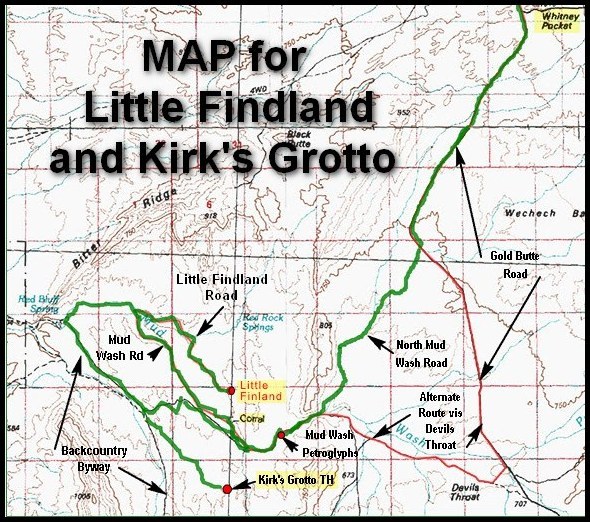{Click on an image to enlarge, then use the back button to return to this page}
This page last updated on 03/14/2018
 |
| (Fig. 01) |
 |
| (Fig. 02) |
Directions: The drive to Little Finland starts along Gold Butte Road, 3 miles from I-15 exit 112. This narrow road runs alongside the east bank of the Virgin River. Drive south on this road to Whitney Pocket, about 19 miles. The surface is good at first but becomes more bumpy as the route turns southeast, climbing into the hills then descending after a while to a wide plain. Continuing straight on, the road becomes partially unpaved though still relatively good, as it crosses desert flats, until it reaches Whitney Pocket. We used this spot as a staging area and off-loaded the ranger here. Although still a major backcountry route, the surface is now unpaved and noticeably more uneven, formed of hard-pressed stones, and it becomes steadily rougher. At about 3 miles from Whitney Pocket you can take North Mud Wash Road to the right (the route in green on (Fig. 02) that we took today) or continue on for a total of 7.2 miles to Devils Throat, where you can head westwards on Mud Wash Road (The road marked in red on (Fig. 02)). This road follows close to (or directly along) the wash for 6.6 miles. The final section (about 2 miles) runs back east, up a tributary drainage to the base of the Little Finland plateau. This wash has in the past been fenced off by the BLM a little way from the plateau, entailing an extra half mile walk, but the barrier has recently been removed. It is now possible to drive to the base of the cliffs, or up to the plateau next to the formations. The route was in very good condition - no problem with high clearance 4WD.
Description: Little Finland is not officially named and people have called it by many different names (aka Hobgoblin's Playground and Devil's Fire). It is a plateau of red/orange Aztec sandstone covering an area that is about 2,000 feet by 400 feet, where wind and water has heavily eroded the surface into thousands of fantastical shapes and amazingly complex and intricate forms. The formations are the result of sandstone that has been hardened and shaped by wind and water erosion. It has been said that about 150 to 200 million years ago, sandstone deposits were covered by younger sand dunes and solidified. About 10 to 16 million years ago, the stone uplifted and groundwater left minerals that clung to the rocks and hardened, causing harder patches, which erodes at different speeds, resulting in the unique shapes you see today. From the base of the wash, a short scramble leads up into Little Finland plateau, which stretches out for about 0.4 miles to the north. Though you can seem many of these unique features from below (Fig. 01), getting up on the cliff with them makes photographing them much easier. Exploration is easy because the area is fairly level. The area is truly amazing. The farther you go and the more you look, the more you find, but this is more of an elfin wonderland than an area of towering pillars. Probably the most fascinating thing about this place is the fantasyland of shapes (Fig. 05) found in the thousands of small erosional fins, hence the name Little Findland. Almost every rock seems to remind you of an animal, face, or some type of mythical creature (Fig. 06 thru 09). The majority of them are only 3 ft. tall, but some are smaller, others, larger (Fig. 10). Mixed in with the intricate red rock sculptures are fields of virtually white sandstone with sinuous waves, remnants of ancient sand dunes. In other places, the rock is covered with a thin bluish-white crust, the result of salt that has crystallized out of groundwater running through the rock.
03/14/2018 Trip Notes: Today, Harvey Smith, Bob Croke Jim Herring and I made yet another visit to Little Findland, as well as Devil's Throat, Mud Wash Petroglyphs and Kirt's Grotto. For pictures and a description of this visit, go to ... Visit to Gold Butte National Monument - Trip Notes for 03/14/2018.
06/10/2015 Trip Notes: This was our second attempt at locating this spot (see 02/05/14 trip notes below) and were really glad that we made the effort. As you can see from the pictures below (Figs. 05 thru 10), this site has some of the most interesting geologic sandstone formations you will see anywhere in the Southwest. If you follow Little Findland Road (Fig. 02) to the end, you end up at a fenced wash (Fig. 03). I think this might be a tributary of Red Rock Springs. You then have to retrace your steps back to the wide open area in the wash (Fig. 04), whereupon you will be confronted with a 100 foot cliff lined with a half dozen palm trees at its base. Though you can see some of these weather worn sculptures along the upper edge of this cliff (Fig. 01), you really need to climb to the top of the ledge to appreciate the true splendor of this area. One can literally spend hours walking thru this area looking for shapes that remind you of something. I could easily visit this area again. On our return back to Whitney Pocket we stopped at the old coral (Fig. 11) located on Mud Wash Road (Fig. 02).
 |
| (Fig. 03) |
 |
| (Fig. 04) |
 |
| (Fig. 05) |
 |
| (Fig. 06) The Raptor |
 |
| (Fig. 07) Head of a Rino |
 |
| (Fig. 08) Wings of a Chariot |
 |
| (Fig. 09) Jaw of a Crocodile |














